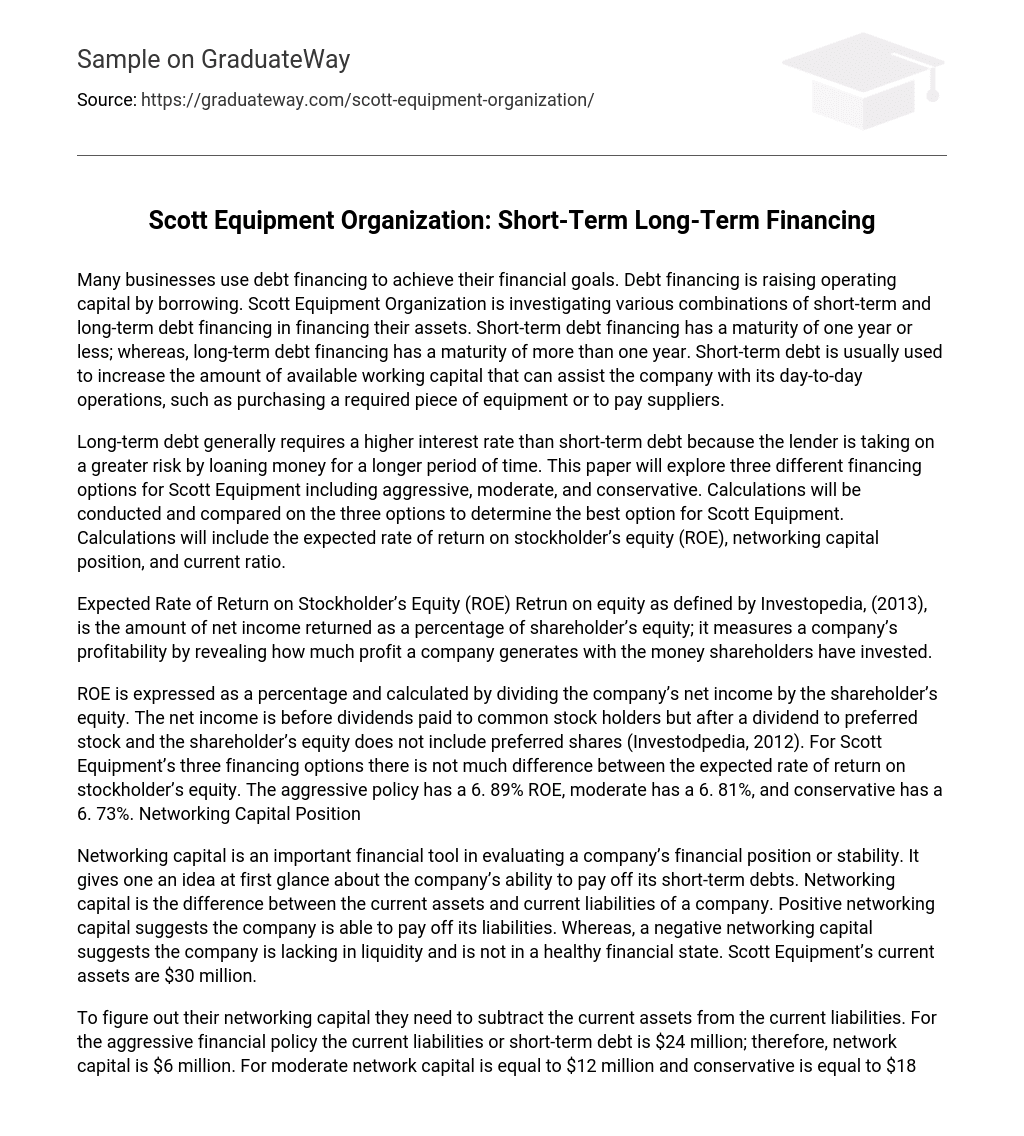Debt financing is frequently employed by businesses to accomplish their financial objectives. Scott Equipment Organization is presently evaluating various possibilities for merging short-term and long-term debt financing in order to fund their assets. Short-term debt financing has a duration of one year or less, while long-term debt financing extends beyond one year. The primary aim of utilizing short-term debt is typically to increase the working capital accessible for day-to-day operations, such as procuring essential equipment or settling payments with suppliers.
The interest rate for long-term debt is typically greater than that of short-term debt due to the increased risk involved in lending money over a longer period. This study investigates three financing choices – aggressive, moderate, and conservative – for Scott Equipment. The article will evaluate and compare these options using calculations pertaining to stockholder’s equity (ROE), networking capital position, and current ratio in order to ascertain the optimal selection for Scott Equipment.
The rate of return on stockholder’s equity (ROE) is the net income earned as a percentage of shareholder’s equity. Investopedia defines ROE as a measure to assess a company’s profitability by showcasing the profit generated through shareholders’ invested funds.
ROE, or Return on Equity, is a financial metric expressed as a percentage. It is calculated by dividing the net income of a company by its shareholder’s equity. The net income used in this calculation excludes any dividends paid to common stockholders but includes dividends paid to preferred stockholders. Notably, preferred shares held are not considered when calculating shareholder’s equity (Investopedia, 2012).
Scott Equipment offers three financing options with similar expected rates of return on stockholder’s equity. The aggressive policy yields a 6.89% ROE, the moderate policy yields a 6.81% ROE, and the conservative policy yields a 6.73% ROE.
Networking Capital Position
Networking capital is crucial for evaluating a company’s financial position and stability, as it measures the difference between its current assets and liabilities. This metric offers a rapid understanding of the company’s ability to pay off short-term debts. A positive networking capital signifies that the company can meet its obligations, whereas a negative networking capital suggests insufficient liquidity and an unfavorable financial state. For example, Scott Equipment currently holds $30 million in current assets.
According to “Accounting Tools” (2013), to determine their networking capital, Scott Equipment must subtract the current liabilities from the current assets. With an aggressive financial policy, the short-term debt or current liabilities is $24 million, hence resulting in a network capital of $6 million. The moderate network capital amounts to $12 million, while the conservative network capital is valued at $18 million. It is crucial for Scott Equipment to closely monitor their working capital, as neglecting investments in receivables, inventory, and payables could lead to an urgent need for cash.
Scott Equipment’s business operations rely on having sufficient resources to meet immediate financial obligations. This is determined by the current ratio, which measures a company’s ability to pay short-term debts with short-term assets. The calculation involves dividing the company’s current assets by its current liabilities. A higher current ratio signifies better debt-paying capability, while a ratio below one indicates potential difficulties in settling obligations when they are due (Investopedia, 2013).
Companies experiencing difficulties in collecting payments for their receivables or facing slow turnover of inventory may encounter liquidity problems due to their inability to decrease their obligations. In the case of Scott Equipment, all three financial policies show that the company is in a solid financial state. Aggressive, moderate, and conservative policies all exhibit a current ratio higher than one. Nonetheless, the conservative policy presents the highest ratio, suggesting that adopting a conservative approach provides the maximum liquidity and enables repayment of short-term debts using short-term assets. Profitability Compared to Risk
Risk refers to the possibility of a company becoming insolvent and unable to meet its payment obligations. Balancing profitability and risk involves striving for minimal risk in order to achieve maximum returns. Lower risks are associated with lower potential profits, while higher risks offer the potential for greater gains. To mitigate the risk of sudden interest rate increases, long-term funds can be employed as they lock in funding costs for an extended period, ensuring accessibility when needed.
Short-term funds are generally less expensive compared to long-term funds, but there is a potential risk of being unable to refinance for seasonal needs. A cautious approach involves using long-term debt for both seasonal and permanent requirements, while an assertive approach entails utilizing short-term debt for seasonal needs and long-term debt for permanent needs. The conservative strategy is deemed as having low risk and low profitability, whereas the aggressive strategy carries high risk but is expected to yield higher profitability. The moderate approach lies between conservative and aggressive strategies, striking a balance between levels of risk and profitability.
According to the table for Scott Equipment, the aggressive policy leads to high profitability, with higher net income and the highest return on equity. However, the aggressive policy also carries high risk due to low current ratio and lower networking capital. By adopting the aggressive policy, Scott Equipment might face reinvestment rate risk and potential refinancing at higher rates. Moreover, they may encounter difficulties in obtaining refinancing for their short-term debt.





